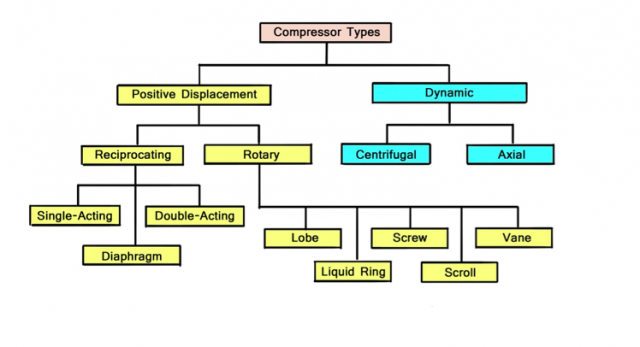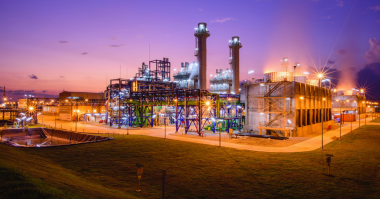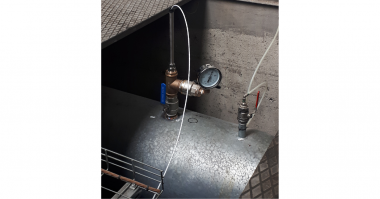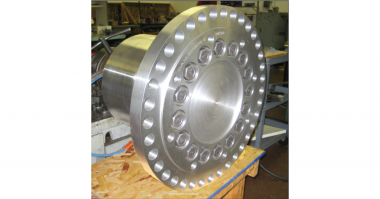Author: Robert X. Perez, Machinery Engineer
Compressor Types
Compressors come in many different designs in order to handle a wide variety of process applications. The two most common compressor designs are positive displacement and dynamic (see Figure C). Positive displacement compressors include reciprocating and rotary units (see Figure D). Positive displacement compressors work by continually forcing gas into a smaller and smaller volume, using either a piston or tight-fitting rotors, and then expelling the reduced volume of gas into a discharge passageway.
Figure D shows a cross section of a rotary screw compressor composed of two tightly fitting rotors inside a pressure containing housing. Positive displacement compressors generally deliver smaller gas volumes and much higher differential pressures than centrifugal or axial flow compressors. Piston compressors have a potential drawback of discharging the gas flow in pulses, which some processes may not be able to tolerate.

Figure D—Rotary Screw Compressor
Centrifugal compressors (see Figure E) and axial compressors fall in the category of dynamic compressors. This type works by accelerating gas with a rotating impeller or set of rotating blades and then converting the exiting high velocity gas stream into a higher pressure by decelerating the gas stream for the next compression stage. Like centrifugal pumps the inlet of a centrifugal compressor is larger than the outlet making it easy to identify the inlet and outline nozzles when tracing down the piping. The output of these compressors tends to be continuous, with very low pressure pulsations. However, because dynamic compressors create pressure due to aerodynamic effects, they are susceptible to a flow condition called surging, which is characterized by violent, periodic flow reversals followed by the reestablishment of flow from suction to discharge. This is a serious operating condition that should be avoided. Surging can be detected either by a characteristic sound or, if equipped with proximity thrust probes, by the periodic back and forth axial movement of the rotor.
Centrifugal and reciprocating compressors are the type most often found in most petrochemical processes. Centrifugal compressors are used whenever high gas flows must be delivered at low to moderate differential pressures. Reciprocating compressors are used whenever low to medium gas flows must be delivered at high differential pressures. For extremely high delivery pressure (up to 50,000 psi) applications, special reciprocating compressors, called hyper-compressors, are utilized.
Multi-staging
Because the act of compression heats up the gas, there is a limit to how much gas pressure can be raised across any given compressor stage. Higher and higher pressures can be achieved by placing multiple stages of compression in series, that is, having the discharge of one stage of compression feed the intake of the next stage and so on (see Figure E). “Multi-staging” is the term used whenever multiple stages are used to meet the pressure requirements of a given application. Both reciprocating compressors and centrifugal compressors can be configured in multistage arrangements. If the temperature from one compression stage is predicted to get excessive, then inter-stage cooling is required to drop the gas temperature to a safe level before entering the next stage. Problems with inter-stage cooling systems can result in loss of flow, pressure capability, and in surging.

Figure E—Multistage Centrifugal Compressor
Key Reliability Indicators
Some increase in the gas temperature is normal and expected. Many compressors have inter-coolers or after-coolers to handle this expected increase in temperature. However, whenever internal compressor issues, such as internal recycling, fouling, etc., are present, gas temperatures can rise well above what is expected. For this reason, compressor temperatures should constantly be closely monitored as a means of detecting internal problems. If high temperature conditions are not detected early, they can lead to the degradation of internal non-metallic elements, which in turn can escalate into a major failure. These high temperatures can also lead to compressor surges. It is best to set a temperature alarm at the discharge of every compressor stage that is somewhat below the shutdown level. If the alarm sounds, you will have time to investigate the problem before the compressor automatically shuts down.
Early intervention may prevent a loss of run time productivity. This is another case where knowing what “normal” is and knowing what the temperature was yesterday, last week, and last month is critical to detecting problems early.
Vibration is another major concern with an excellent indicator of mechanical condition of compressors. Vibration can be caused by imbalance, flow issues, foundation problems, internal looseness, etc. Make sure to monitor piping and skid vibration around reciprocating compressors as well as the working components. When reporting a vibration problem, note any special conditions present when the abnormality occurs, such as the rotational speed or process conditions. These notations can be very helpful during troubleshooting later.
About the Author:
 Robert X. Perez has over 30 years of rotating equipment experience in the petrochemical industry. He earned a BSME degree from Texas A&M University (College Station), a MSME degree from the University of Texas at Austin, and is a licensed professional engineer in the state of Texas. Mr. Perez served as an adjunct professor at Texas A&M University-Corpus Christi, where he developed and taught the Engineering Technology Rotating Equipment course.
Robert X. Perez has over 30 years of rotating equipment experience in the petrochemical industry. He earned a BSME degree from Texas A&M University (College Station), a MSME degree from the University of Texas at Austin, and is a licensed professional engineer in the state of Texas. Mr. Perez served as an adjunct professor at Texas A&M University-Corpus Christi, where he developed and taught the Engineering Technology Rotating Equipment course.
He authored four books and coauthored four books in the field of machinery reliability. Mr. Perez has also written numerous machinery reliability articles for numerous technical conferences and magazines.





Comments